Savor Puebla, a Mexican gem known for its food and sense of style

We visited Puebla, Mexico, in July 2017 -- colonial buildings, rich sauces, colorful tilework, welcoming people. Then came a big earthquake in September. Here’s what we found when we revisited Puebla in February. Photos and video by Wally Skalij and
Look west on a clear day from any hilltop in Puebla. In the suburb of Cholula, seven miles outside downtown, you’ll spy an orange church and a snow-topped peak looming behind it.
This church is Nuestra Señora de los Remedios, built in the 1570s, damaged by a major earthquake on Sept. 19, now whole and open again. The peak is the volcano Popocatépetl, alive and fuming.
That curiously symmetrical hill beneath the church? That’s not a hill at all.
It’s the Great Pyramid of Cholula, the largest known pyramid on Earth, begun before Christ, completed long before the Spanish arrived, now cloaked in vegetation.
Consider this easy-to-misread scene a fair warning: Puebla, about 85 miles southeast of Mexico City, is full of earthen surprises, architectural wonders and human resilience.
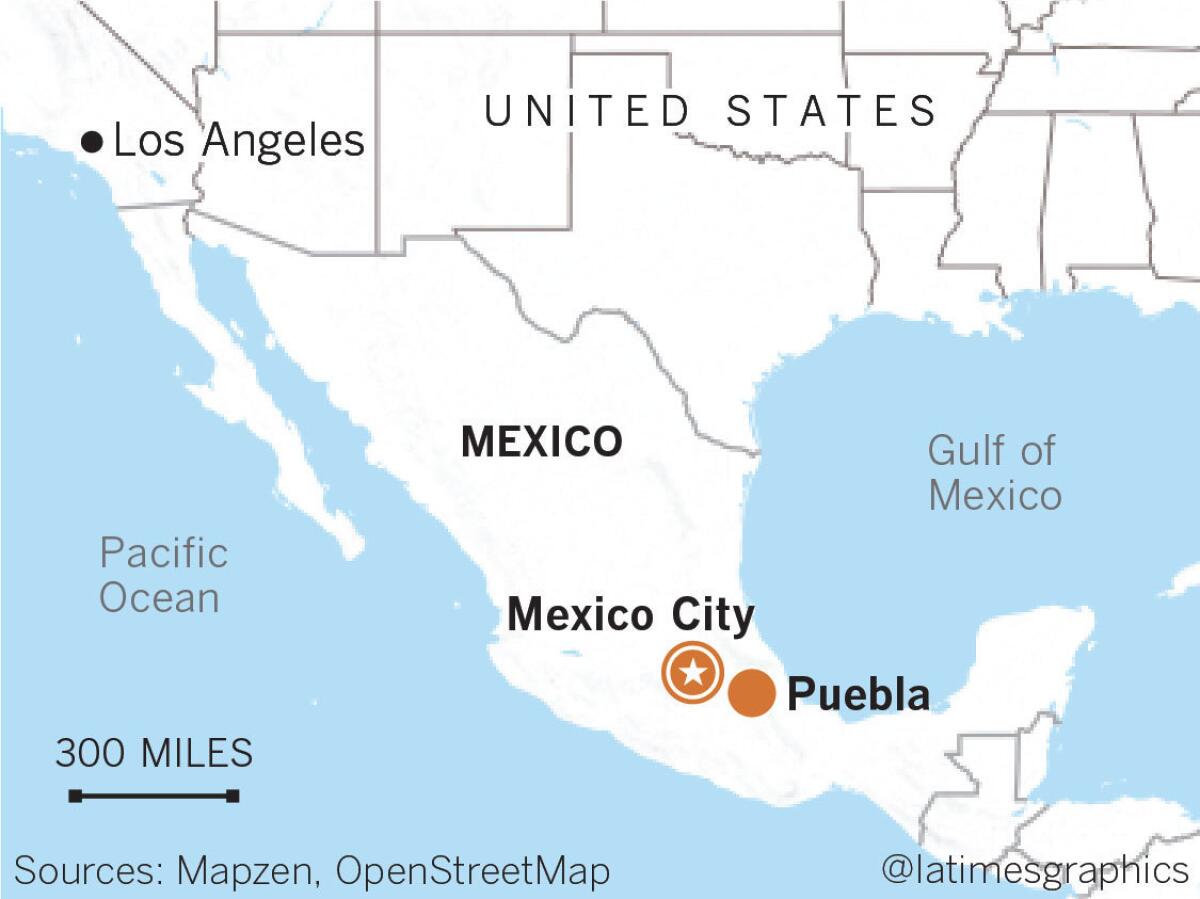
I know this from two visits. I spent five days here in July gathering information for a travel article that was to be published in the fall. Then came the magnitude-7.1 Mexican earthquake of Sept. 19, which killed about 220 people in Mexico City, 74 in the state of Morelos and 45 in the state of Puebla, most of them in small, outlying towns. I shelved the story.
But in the days and weeks after, it became clear that Puebla, whose downtown core includes more than 2,500 colonial buildings from the 16th to 18th centuries, had survived remarkably intact. I returned in February.
I found scaffolding on several buildings and heard from several vendors and hoteliers about the post-quake slump in visitation. A taxi driver pulled out his phone to show me video of the Cholula church losing the tops of its two towers.
But five months after the temblor, just one visitor attraction remained shut because of quake damage— the 18th century Casa de Alfeñique museum, closed indefinitely.
Meanwhile, the list of what endures in Puebla is long and wonderful enough that it might astonish a newcomer.
You’ll pass shops offering locally made talavera ceramics and restaurants serving mole poblano, a savory sauce that has won admirers with its nearly infinite combinations of chiles, seeds, nuts and other ingredients.
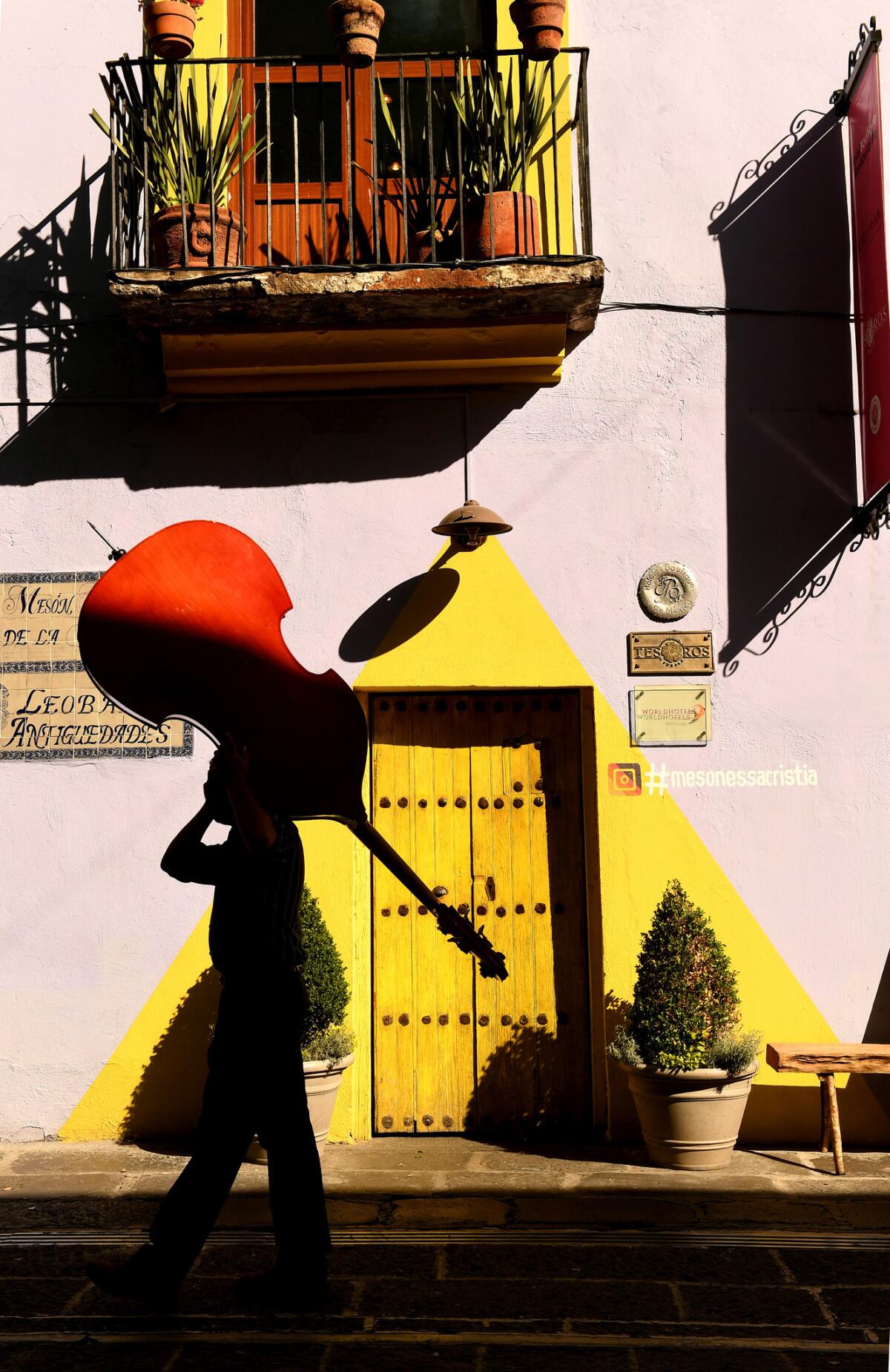
View more photos of Puebla, Mexico »
You may find stylish international twentysomethings browsing in boutiques along Callejón de los Sapos, where storefronts are painted in rainbow sherbet hues.
And somebody will remind you that Puebla is the reason many people celebrate Cinco de Mayo. On that day in 1862, Mexican forces in the city won a crucial but temporary victory against the French.
Oh, and if you mention that you’re from Los Angeles, someone may point out that when this place was founded in 1531, its name was Puebla de los Ángeles.
Here’s some of what I found in this other city of angels, beginning with recent additions and rediscoveries.
Open for business
At the base of the Great Pyramid, the Regional Museum of Cholula opened in 2017 to highlight the area’s pre-Hispanic cultures in buildings that used to be a former psychiatric hospital. A block away, a tourist train (also opened in 2017) offers service to downtown Puebla for about $4 each way.
In early 2016, the International Museum of the Baroque opened in the Puebla suburb of Angelópolis; its displays, monitors and projections are housed in a startling building by Japanese architect Toyo Ito. This museum is as white as Getty Center, as curvy as Disney Hall and as minimalist as its contents are elaborate.
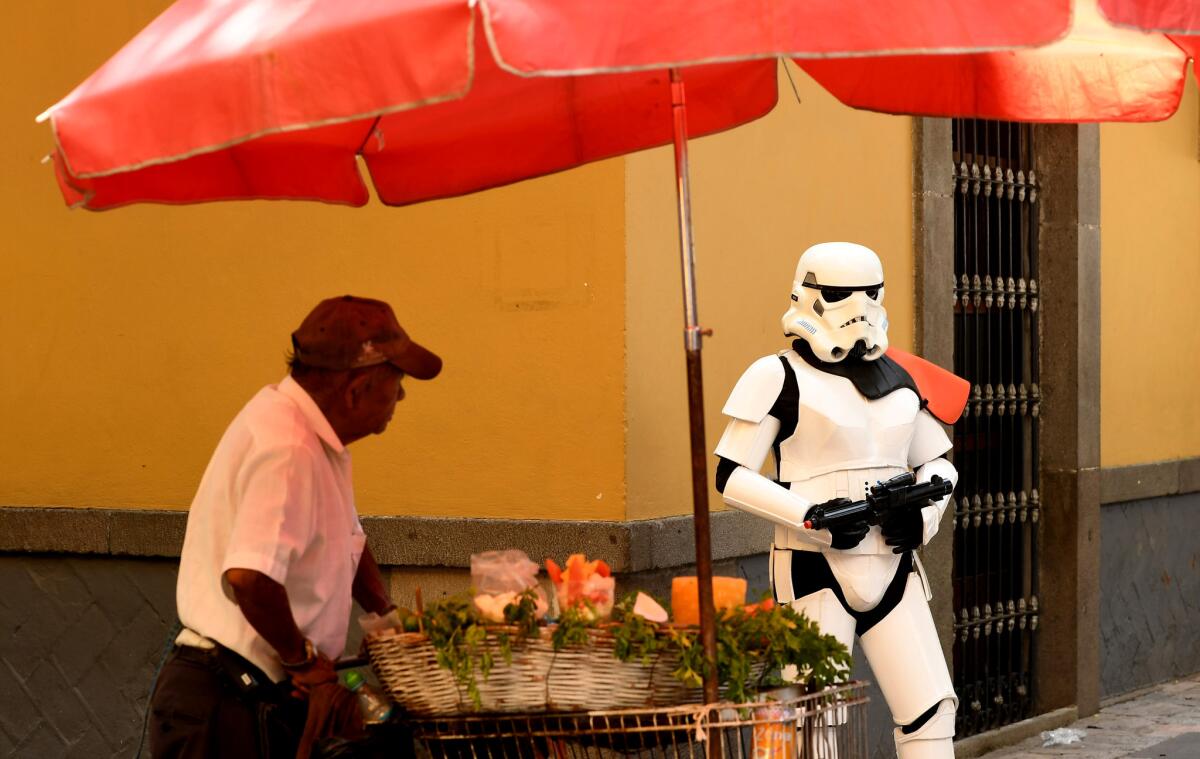
The Cableway of Puebla aerial tram opened in 2016 at the city’s convention hall, two miles northwest of the city center. Pay about $4 for a round trip, and from aloft, you’ll see that an entire neighborhood’s roofs and walls have been painted in blue and white patterns as though they were a vast piece of talavera pottery.
In the central Barrio del Alto, a luxurious Rosewood Hotel opened in early 2017 in a rehabilitated compound of historic buildings. Another luxury lodging, Hotel Cartesiano, opened in late 2017 near Callejón de los Sapos.
Swimming with giant sharks in Baja, Mexico »
Also, there are the tunnels. On my first visit, guide Daniel Lima led me to some stairs labeled Pasaje 5 de Mayo and told me how, when he was a kid, “our grandparents told us legends about tunnels under the city” — legends that turned out to be true.
Archaeologists discovered these tunnels in about 2012. Researchers found a series of underground passages, dating back at least 150 years, beneath some of the city’s busiest blocks.
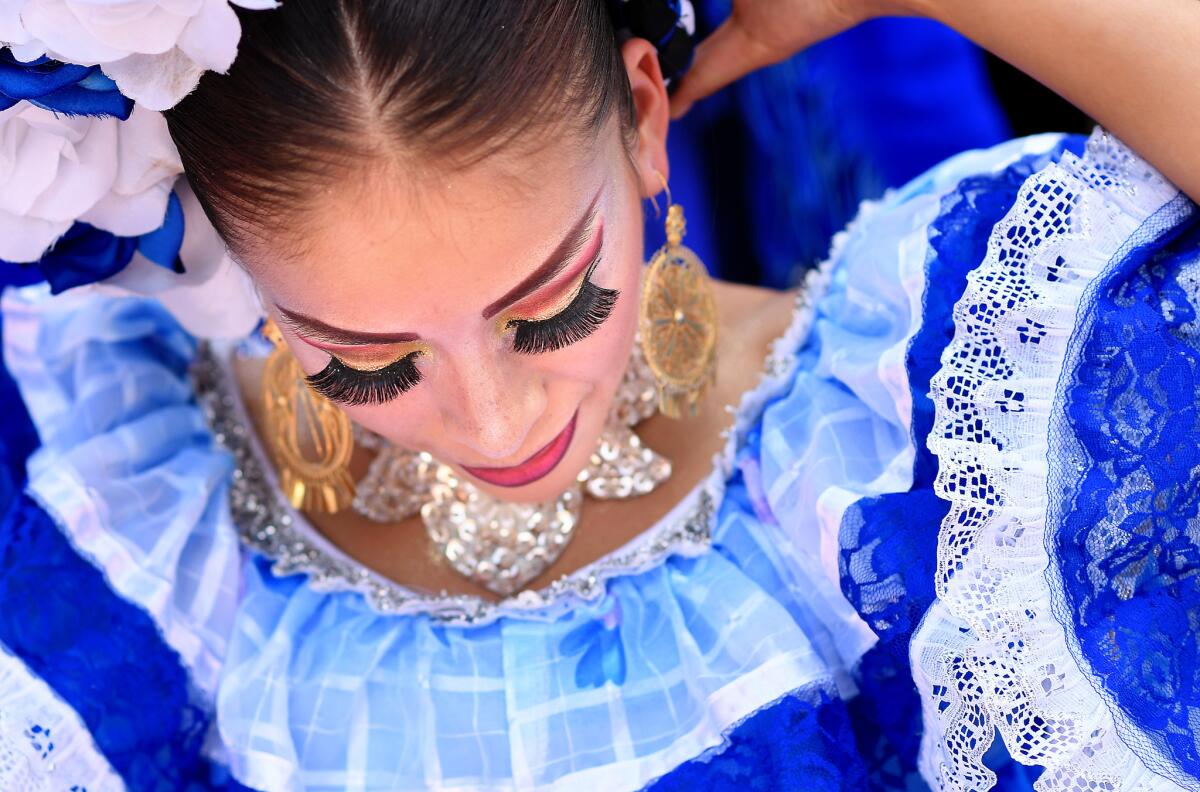
View more photos of Puebla, Mexico »
For now, just a few segments, dubbed Los Secretos de Puebla, have been shored up and opened to the public. (And yes, they survived the quake just fine.) Locals and tourists like me strolled through for about $1.50. Colored lights played on the stone walls, and the P.A. system issued a spooky soundtrack of galloping hoofs and war cries, evoking the battle of 1862.
(I walked through the tunnels — and a narrower passage under the Cholula pyramid — in July and again in February.)
The working-class neighborhood of Xanenetla, where two tunnel segments surface, has risen to the occasion by covering its walls with dozens of playful murals.
My base for these explorations was the tranquil Quinta Real hotel, a converted 16th century convent. But next time, I may try Casa del Callejón, a 10-room boutique hotel upstairs from the see-and-be-seen sidewalk tables of the Café Santo Patrono.
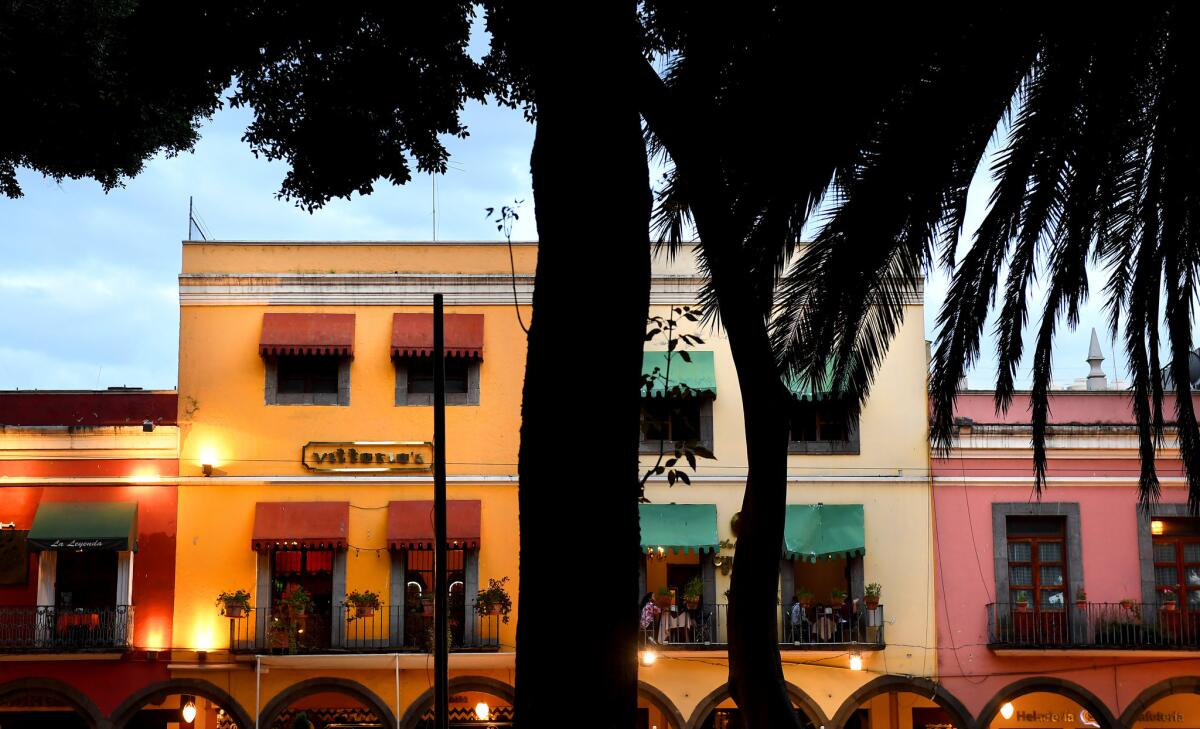
Either way, a traveler can do what I did, strolling through the zócalo at every opportunity, measuring its lazy mornings against its bustling nights.
Two blocks north of the zócalo, be sure to step into the Church of Santo Domingo’s Rosary Chapel, where you can see Spanish baroque design in full flower. On the way into the church on my second visit, I saw a team of workers repairing quake damage to the facade.
To see a little of the city’s semi-rural outskirts — and a pair of remarkable colonial churches — combine a day trip to Cholula with a stop at the Church of Santa María Tonantzintla,about six miles southwest of Cholula, where you can see lavish details on the interior walls along with sculpted brown faces that resemble residents of the rustic town.
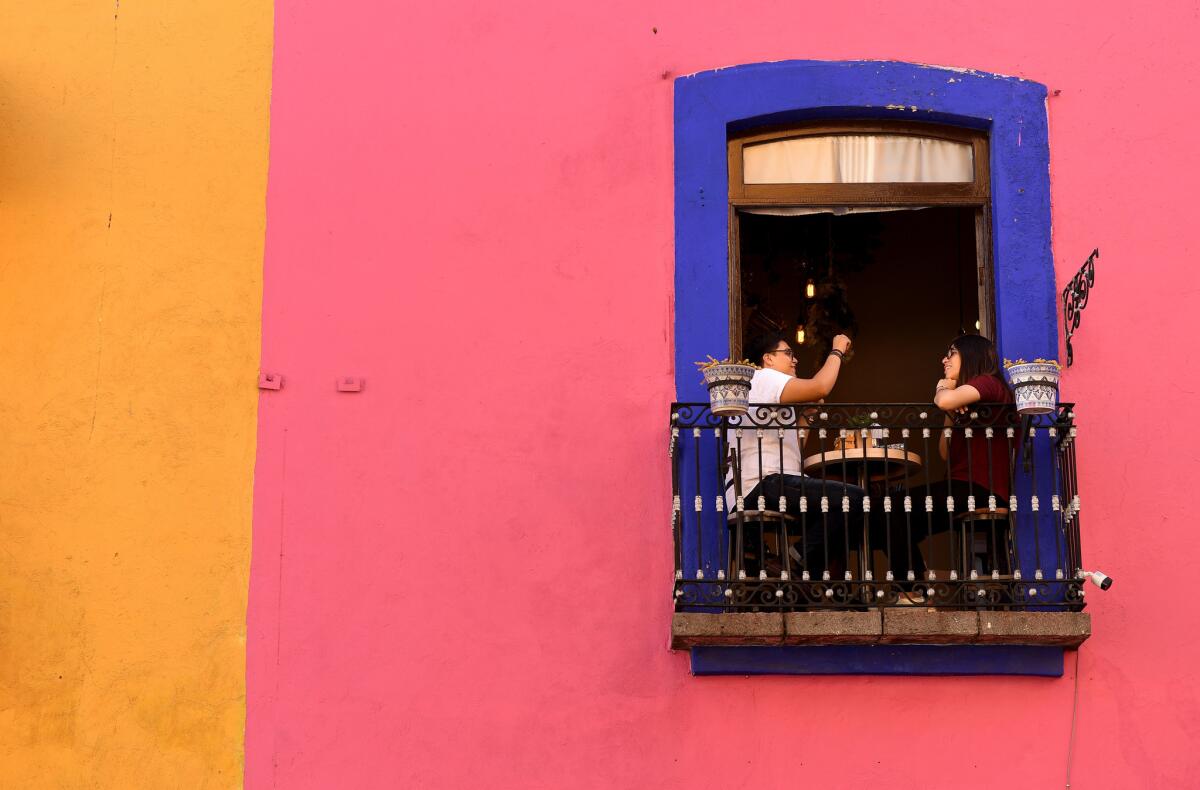
View more photos of Puebla, Mexico »
Then head a mile south to the Church of San Francisco de Acatepec, where you’ll find a red-tile-and-talavera facade that mesmerizes with its riotous colors, geometric patterns and mismatched towers. During my February visit, both churches were open while quake repairs were underway.
Mole and more
I ate well — no surprise in a city that calls itself “the kitchen of Mexico.” The stylish Casareyna in Puebla’s Barrio San Francisco served my favorite mole over chicken. (And there’s a chic little Casareyna hotel upstairs.)
At El Mural de los Poblanos, one of the busiest restaurants in the central historic district, a kind waiter talked me into my first chiles en nogada — stuffed poblano chiles in walnut cream sauce dotted with pomegranate seeds. Thumbs up.
At Antigua Taquería La Oriental, a fixture on the zócalo since the 1930s, I grabbed a hearty taco árabe (marinated pork wrapped in pita bread instead of a corn tortilla) for about $1.25
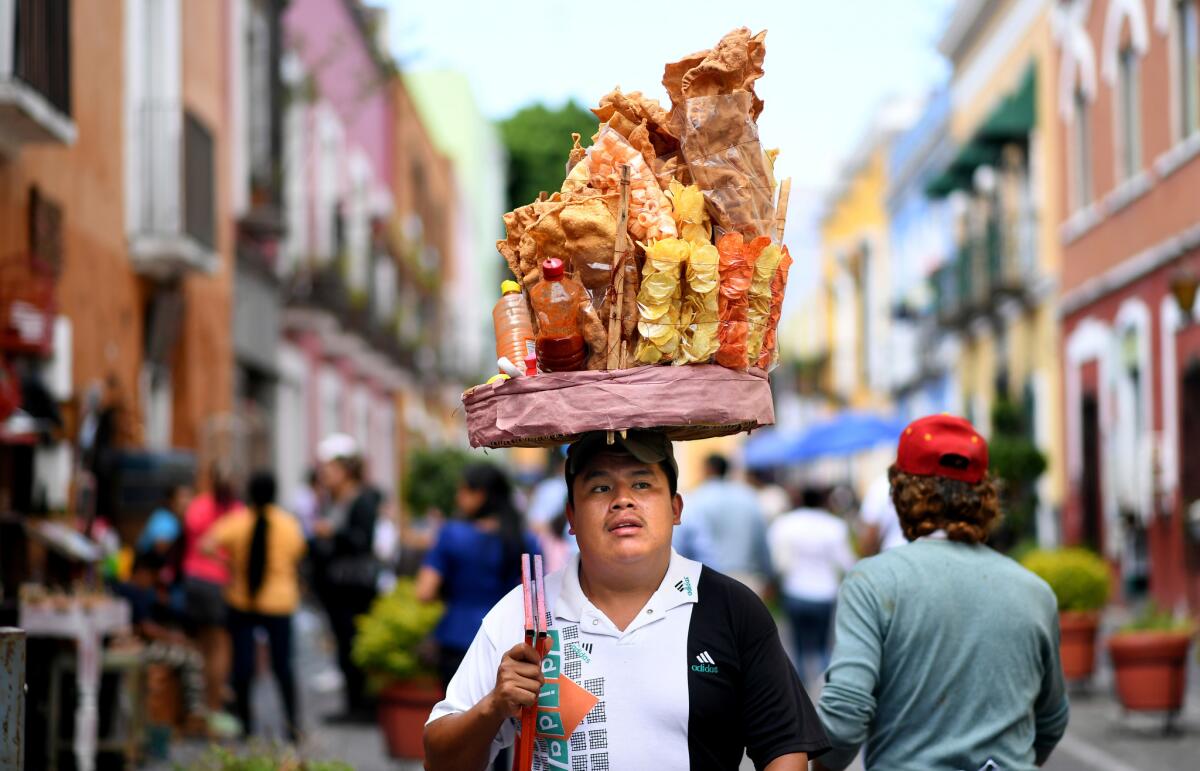
At La Berenjena, two blocks southwest of the zócalo, I strayed from traditional Mexican cuisine and was rewarded with a great carpaccio pizza. Another evening, I lingered over a simple $8 dinner of salad and Serrano ham at La Profética bookshop and café.
From street vendor Faustina Juárez in Xanenetla, I bought a $1 quesadilla with mushrooms that brought me deep happiness. At the Parian Market, Anayeli Garcia sold me a $2 bag of roasted grasshoppers (chapulines) and immediately crossed herself.
“My first sale of the day,” she said in Spanish.
In seven days of meals during the two visits, only one underwhelmed me — a bland chicken mole at Nevados, overlooking the zócalo. The least interesting food is always at the place with the best view, right?
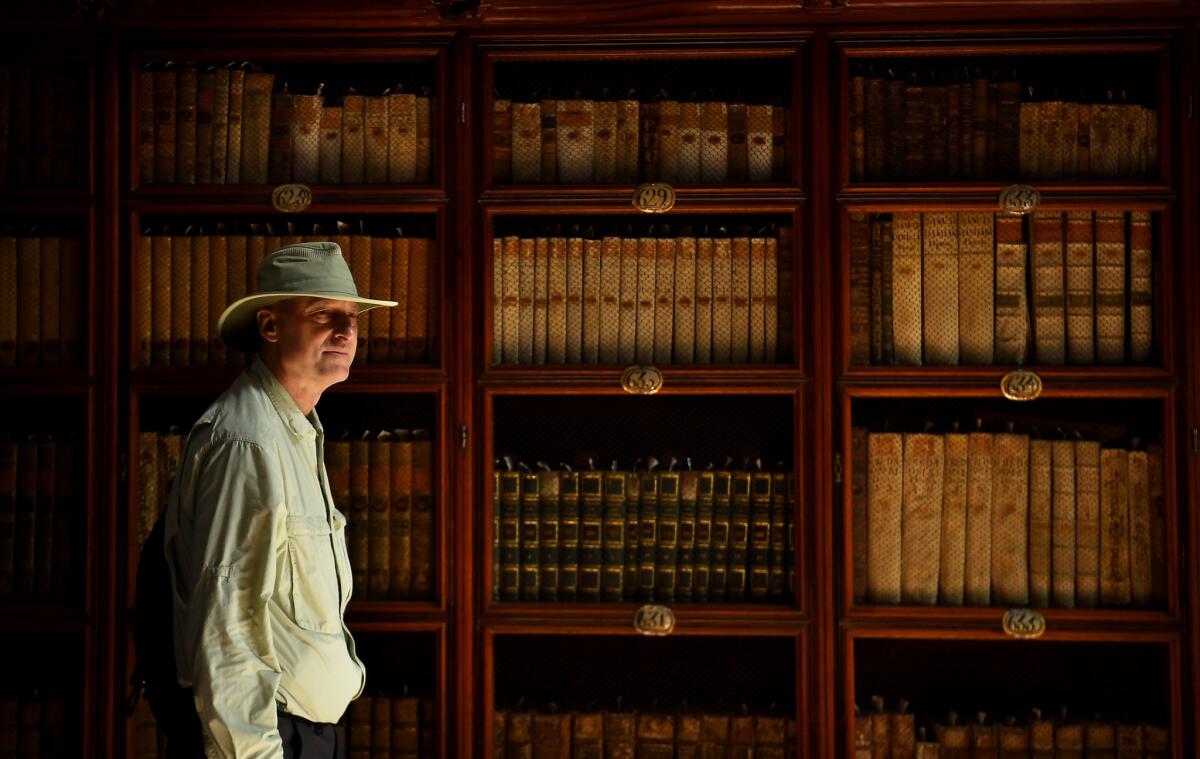
View more photos of Mexico, Puebla »
I should mention that throughout these meanderings, I felt as safe as I do in Burbank or Glendale. The Puebla area has seen conflict as government forces confront pipeline-tapping fuel thieves, but it has been largely free of drug-related crime. The U.S. State Department, which uses a 1-4 scale in assessing risks to travelers abroad (4 being the most dangerous), gives the state of Puebla a 2 (“exercise increased caution”).
Another nice thing: I never ran out of discoveries. At the Museo Amparo, I looked at pre-Hispanic sculptures. At the Biblioteca Palafoxiana, which UNESCO says may have been the first public library in the Americas, founded in 1646, I lingered under the arched ceilings, wondering how to say “Hogwartsian” in Spanish.
And at La Pasita in Barrio de los Sapos, the oldest and tiniest cantina in town, I downed a shot of local raisin liqueur. The shot cost about $1.50. It was sweet and served by an elderly bartender with the mien of a homicide detective. Whatever changes come next for Puebla, this guy will be ready to carry on.
Mexico City bounces back
Six months after this capital’s last major earthquake, its most popular tourist attractions are busy again.
If you’re headed here, remember that the metropolitan area is built on an ancient lake bed. For generations, as the growing city has drawn down the aquifer beneath the lake bed, the ground has been sinking unevenly, leaving the city vulnerable to quakes.
The magnitude-8 quake of 1985 killed at least 5,000 people. The magnitude-7.1 quake of Sept. 19 killed more than 225 people in the city and many more outside it. Many buildings remain shut or under reconstruction, especially in the Roma and La Condesa neighborhoods.
But it was a return to business as usual at every major stop I checked in mid-February along the tourist trail. Tour operators say the same is true at the pyramids of Teotihuacán, about 30 miles northeast of the city center.
The Metropolitan Cathedral, begun in 1573 and completed in 1813, looms over the zócalo at the center of the city. The World Monuments Fund calls it the largest church in Latin America and notes that since the 1990s, engineers have been working to stabilize its uneven floors.
In September’s quake, the cathedral escaped major damage, but authorities said a statue of Hope (the theological virtue) was toppled from its spot on the clock tower. Though Hope-less for the foreseeable future, the cathedral remains open daily, as do the neighboring zócalo (a.k.a. Plaza de la Constitución) and Templo Mayor ruins.
The star of the city’s Parque Alameda Central, three-quarters of a mile west of the zócalo, is the Palacio de Bellas Artes, an Art Nouveau building (with Tiffany glass crown) designed by Italian architect Adamo Boari.
The Palacio, a city symbol and venue for performing arts since 1934, reopened within two weeks of the September quake. For a bird’s-eye view, head to the eighth-floor terrace snack bar of the Sears store across the street.
Xochimilco’s canals are about 15 miles south of the zócalo — typically an hour’s drive. But the canal system’s Embarcadero Nuevo Nativitas area, which bore no signs of quake damage, was well worth my trouble.
Rent a brightly painted boat (and pilot) for about $28 an hour. Buy snacks; listen to musicians. The canals, which date to pre-Hispanic times, go on for miles, and they’re threatened by pollution and dwindling water supply. But I saw more smiles there than any place else in the city.
Among other attractions operating as usual: the Palacio Nacional and Ministry of Education buildings, which include some of Diego Rivera’s best-known murals; the Frida Kahlo Museum in Coyoacán; the Museo Soumaya (with art from Europe, Asia and the Americas); Museo Jumex (contemporary art); the Casa de Azulejos (a 16th century building with tiles outside and a Sanborn’s restaurant inside); Chapultapec Park (which includes the National Museum of Anthropology); Plaza Garibaldi, where mariachi groups gather; and the 45-story Torre Latinoamerica’s restaurant and observation deck.
If you go
THE BEST WAY TO PUEBLA, MEXICO
From LAX, Aeromexico, American, United and Delta offer connecting service (change of planes) to Puebla. Restricted round-trip air fare from $440, including taxes and fees.
TELEPHONES
To call the numbers below from the U.S., dial 011 (the international dialing code), 52 (country code for Mexico), 222 (the area code) and the seven-digit local number.
GETTING AROUND
The easiest way to the Cholula Archeological Zone is the Puebla-Cholula Tourist Train, an 11-mile, 40-minute ride. The price is about $4 for visiting adults, half that for Puebla residents. Trains depart three or four times per day (depending on the day) from the Puebla Terminal, 11 Norte and Esquina 18 Poniente, Colonia el Tamborcito, Puebla.
WHERE TO STAY
Quinta Real Puebla, 105 Calle 7 Poniente, Centro, Puebla; 55-1105-1000. Doubles from about $140 a night, taxes and fees included.
Rosewood Puebla Hotel, 1402 Calle 10 Norte, Col. Barrio del Alto, Puebla; 122-2300. Luxe property with 78 rooms. Doubles from about $325 a night, taxes and fees included.
Casareyna Hotel, 1007 Privada 2 Oriente, Centro, Puebla; 232-0032. Sleek, pleasant 46-room hotel with a perplexing website. Call for info. Rooms for two from about $100, taxes and fees included.
Hotel Casa del Callejón, 3 Oriente No. 603, Barrio de los Sapos, Centro, Puebla; 222-6329. Ten rooms above perhaps the city’s trendiest corner. Rates $35-$50, taxes and fees included.
WHERE TO EAT
El Mural de los Poblanos, 506 Calle 16 de Septiembre, Centro, Puebla; 242-0503. Lively and traditional. Breakfast, lunch and dinner. Dinner main dishes $10-$20.
Casareyna Restaurante, 1007 Privada 2 Oriente, Centro, Puebla; 232-0032. Quiet and contemporary. Breakfast, lunch and dinner. Dinner main dishes about $7-$20.
La Berenjena Pizza Artesanal, 3 Oriente No. 407, Centro, Puebla. Also has locations in Cholula and Angelópolis. 688-4754. Fancy pizza, trendy scene. Pizzas $9-$14.
TO LEARN MORE
Sign up for The Wild
We’ll help you find the best places to hike, bike and run, as well as the perfect silent spots for meditation and yoga.
You may occasionally receive promotional content from the Los Angeles Times.




